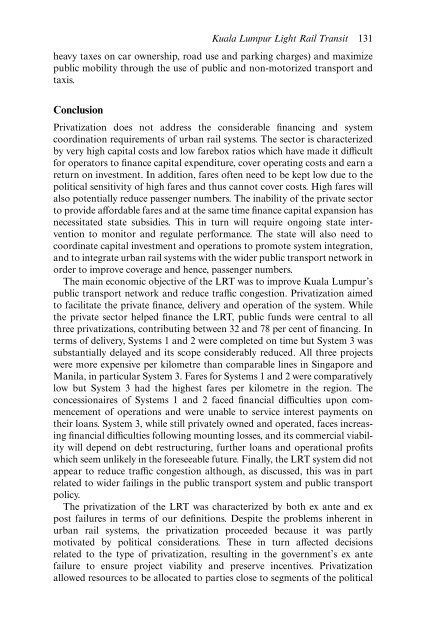PRIVATIZATION Privatization in Malaysia, Regulation, rent-seeking and policy failure
PRIVATIZATION Privatization in Malaysia, Regulation, rent-seeking and policy failure
PRIVATIZATION Privatization in Malaysia, Regulation, rent-seeking and policy failure
You also want an ePaper? Increase the reach of your titles
YUMPU automatically turns print PDFs into web optimized ePapers that Google loves.
Kuala Lumpur Light Rail Transit 131heavy taxes on car ownership, road use <strong>and</strong> park<strong>in</strong>g charges) <strong>and</strong> maximizepublic mobility through the use of public <strong>and</strong> non-motorized transport <strong>and</strong>taxis.Conclusion<strong>Privatization</strong> does not address the considerable f<strong>in</strong>anc<strong>in</strong>g <strong>and</strong> systemcoord<strong>in</strong>ation requirements of urban rail systems. The sector is characterizedby very high capital costs <strong>and</strong> low farebox ratios which have made it difficultfor operators to f<strong>in</strong>ance capital expenditure, cover operat<strong>in</strong>g costs <strong>and</strong> earn areturn on <strong>in</strong>vestment. In addition, fares often need to be kept low due to thepolitical sensitivity of high fares <strong>and</strong> thus cannot cover costs. High fares willalso potentially reduce passenger numbers. The <strong>in</strong>ability of the private sectorto provide affordable fares <strong>and</strong> at the same time f<strong>in</strong>ance capital expansion hasnecessitated state subsidies. This <strong>in</strong> turn will require ongo<strong>in</strong>g state <strong>in</strong>terventionto monitor <strong>and</strong> regulate performance. The state will also need tocoord<strong>in</strong>ate capital <strong>in</strong>vestment <strong>and</strong> operations to promote system <strong>in</strong>tegration,<strong>and</strong> to <strong>in</strong>tegrate urban rail systems with the wider public transport network <strong>in</strong>order to improve coverage <strong>and</strong> hence, passenger numbers.The ma<strong>in</strong> economic objective of the LRT was to improve Kuala Lumpur’spublic transport network <strong>and</strong> reduce traffic congestion. <strong>Privatization</strong> aimedto facilitate the private f<strong>in</strong>ance, delivery <strong>and</strong> operation of the system. Whilethe private sector helped f<strong>in</strong>ance the LRT, public funds were central to allthree privatizations, contribut<strong>in</strong>g between 32 <strong>and</strong> 78 per cent of f<strong>in</strong>anc<strong>in</strong>g. Interms of delivery, Systems 1 <strong>and</strong> 2 were completed on time but System 3 wassubstantially delayed <strong>and</strong> its scope considerably reduced. All three projectswere more expensive per kilometre than comparable l<strong>in</strong>es <strong>in</strong> S<strong>in</strong>gapore <strong>and</strong>Manila, <strong>in</strong> particular System 3. Fares for Systems 1 <strong>and</strong> 2 were comparativelylow but System 3 had the highest fares per kilometre <strong>in</strong> the region. Theconcessionaires of Systems 1 <strong>and</strong> 2 faced f<strong>in</strong>ancial difficulties upon commencementof operations <strong>and</strong> were unable to service <strong>in</strong>terest payments ontheir loans. System 3, while still privately owned <strong>and</strong> operated, faces <strong>in</strong>creas<strong>in</strong>gf<strong>in</strong>ancial difficulties follow<strong>in</strong>g mount<strong>in</strong>g losses, <strong>and</strong> its commercial viabilitywill depend on debt restructur<strong>in</strong>g, further loans <strong>and</strong> operational profitswhich seem unlikely <strong>in</strong> the foreseeable future. F<strong>in</strong>ally, the LRT system did notappear to reduce traffic congestion although, as discussed, this was <strong>in</strong> partrelated to wider fail<strong>in</strong>gs <strong>in</strong> the public transport system <strong>and</strong> public transport<strong>policy</strong>.The privatization of the LRT was characterized by both ex ante <strong>and</strong> expost <strong>failure</strong>s <strong>in</strong> terms of our def<strong>in</strong>itions. Despite the problems <strong>in</strong>he<strong>rent</strong> <strong>in</strong>urban rail systems, the privatization proceeded because it was partlymotivated by political considerations. These <strong>in</strong> turn affected decisionsrelated to the type of privatization, result<strong>in</strong>g <strong>in</strong> the government’s ex ante<strong>failure</strong> to ensure project viability <strong>and</strong> preserve <strong>in</strong>centives. <strong>Privatization</strong>allowed resources to be allocated to parties close to segments of the political


